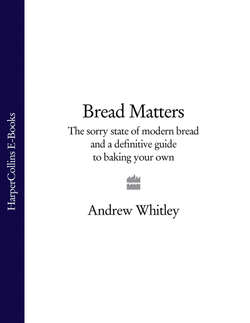Читать книгу Bread Matters: The sorry state of modern bread and a definitive guide to baking your own - Andrew Whitley - Страница 10
This is your loaf
ОглавлениеIn 1961 the British Baking Industries Research Association in Chorleywood, Hertfordshire, devised a breadmaking method using lower-protein wheat, an assortment of additives and high-speed mixing. Over 80 per cent of all UK bread is now made using this method and most of the rest uses a process called ‘activated dough development’ (ADD), which involves a similar range of additives. So, apart from a tiny percentage of bread, this is what we eat today.
The Chorleywood Bread Process (CBP) produces bread of phenomenal volume and lightness, with great labour efficiency and at low apparent cost. It isn’t promoted by name. You won’t see it mentioned on any labels. But you can’t miss it. From the clammy sides of your chilled wedge sandwich to the flabby roll astride every franchised burger, the stuff is there, with a soft, squishy texture that lasts for many days until the preservatives can hold back the mould no longer. If bread forms a ball that sticks to the roof of your mouth as you chew, thank the Chorleywood Bread Process – but don’t dwell on what it will shortly be doing to your guts.
This is Britain’s bread: a technological marvel combining production efficiency with a compelling appeal to the lowest common denominator of taste. It is the very embodiment of the modern age.
Below is a breakdown of a typical Chorleywood Bread Process loaf2. Only the first four ingredients in the table – flour, water, salt and yeast – are essential to make bread. In fact, even yeast (as an added ingredient) is unnecessary for breads made with natural leavens or sourdoughs. Bread made with these three or four simple ingredients was the basis of my bakery business for 25 years. So it is reasonable to ask: are all those other ingredients necessary? And, if not, what are they doing in our bread?
Read on and judge for yourself.
If you are unnerved by all the chemical names, you may be assured that the ingredients and additives listed above have received appropriate regulatory approval. Assured, but not reassured. The same could have been said 20 or 50 years ago, when the list would have contained chemicals that have since been banned. Safety assurance has a short shelf life. The development of modern emulsifiers, and especially of the newer bakery enzymes, was given considerable impetus by the withdrawal of the oxidising ‘improver’ potassium bromate, which after many years’ use was discovered to have carcinogenic potential (it is still used in some countries)3.
Moreover, there is a wider concern that makes it hard to accept today’s scientific consensus on food additives. New chemicals are evaluated on a primarily toxicological basis: feed a great deal of your chosen substance to laboratory rats for a limited period and, if they don’t keel over and die, it can be presumed safe for humans. However rigorous, such procedures clearly do not catch the effects of long-term low-level exposure to novel compounds or altered processes, not to mention the ‘cocktail’ effect of combinations of active agents too numerous or unpredictable to model in the laboratory.
